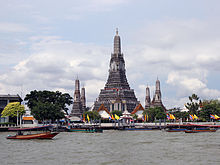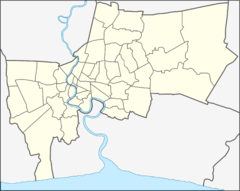วัดอรุณราชวราราม หรือ วัดแจ้ง ถนนอรุณอมรินทร์ แขวงวัดอรุณ เขตบางกอกใหญ่ กรุงเทพมหานคร.
Wat Arun, Bangkok, Thailand.
Photo Gallery. Asian Historical Architecture.
ขอบคุณ ภาพและข้อมูล จาก http://www.orientalarchitecture.com/sid/609/thailand/bangkok/wat-arun
Wat Arun (วัดอรุณ) (18th century onward)
Wat Arun is one of the few Bangkok temples predating the Chakri dynasty, the current rulers of Thailand. When general Phya Taksin crowned himself king in 1769, he moved the capital across the Chao Phraya river to Thonburi. Wat Makok temple fell within the area intended for the king's new palace along the riverbank. The young king designated it the royal temple and changed its name to Wat Jaeng—the Temple of Dawn, a name thought to commemorate the founding of the new dynasty. King Taksin treated the monks badly, expelling them so that he could worship privately in the temple.
Monks were allowed to return during the rule of Rama I, the first King of the Chakri dynasty, who disestablished Wat Jaeng as the royal temple when he moved the capital across the river to what it today downtown Bangkok. His successor, Rama II, renamed it Wat Arun Rajtharam and renovated the temple. He planned to raise the central spire (called a prang) beyond its original 16 meters, but he died before the project was realized. His successor, Rama III, completed the project in the years 1842-1847. The prang was raised to an astonishing 67 meters, making it the highest one in Thailand even today.
The temple is an architectural reproduction of Mount Meru, the center of the world in Buddhist cosmology. The four corner prang, which house images of the guardian gods of the four directions, reinforce the symbolism.
Location
The approximate location of the site is 13.743728' N, 100.488960' E (WGS 84 map datum).
01.Wat Arun, Bangkok, Thailand. Photo Gallery. Asian Historical Architecture.
วัดอรุณราชวราราม หรือ วัดแจ้ง ถนนอรุณอมรินทร์ แขวงวัดอรุณ เขตบางกอกใหญ่ กรุงเทพมหานคร.
วัดอรุณราชวราราม หรือ วัดแจ้ง ถนนอรุณอมรินทร์ แขวงวัดอรุณ เขตบางกอกใหญ่ กรุงเทพมหานคร.
วัดอรุณราชวราราม หรือ วัดแจ้ง ถนนอรุณอมรินทร์ แขวงวัดอรุณ เขตบางกอกใหญ่ กรุงเทพมหานคร.
วัดอรุณราชวราราม หรือ วัดแจ้ง ถนนอรุณอมรินทร์ แขวงวัดอรุณ เขตบางกอกใหญ่ กรุงเทพมหานคร.
วัดอรุณราชวราราม หรือ วัดแจ้ง ถนนอรุณอมรินทร์ แขวงวัดอรุณ เขตบางกอกใหญ่ กรุงเทพมหานคร.
วัดอรุณราชวราราม หรือ วัดแจ้ง ถนนอรุณอมรินทร์ แขวงวัดอรุณ เขตบางกอกใหญ่ กรุงเทพมหานคร.
วัดอรุณราชวราราม หรือ วัดแจ้ง ถนนอรุณอมรินทร์ แขวงวัดอรุณ เขตบางกอกใหญ่ กรุงเทพมหานคร.
วัดอรุณราชวราราม หรือ วัดแจ้ง ถนนอรุณอมรินทร์ แขวงวัดอรุณ เขตบางกอกใหญ่ กรุงเทพมหานคร.
วัดอรุณราชวราราม หรือ วัดแจ้ง ถนนอรุณอมรินทร์ แขวงวัดอรุณ เขตบางกอกใหญ่ กรุงเทพมหานคร.
วัดอรุณราชวราราม หรือ วัดแจ้ง ถนนอรุณอมรินทร์ แขวงวัดอรุณ เขตบางกอกใหญ่ กรุงเทพมหานคร.
วัดอรุณราชวราราม หรือ วัดแจ้ง ถนนอรุณอมรินทร์ แขวงวัดอรุณ เขตบางกอกใหญ่ กรุงเทพมหานคร.
วัดอรุณราชวราราม หรือ วัดแจ้ง ถนนอรุณอมรินทร์ แขวงวัดอรุณ เขตบางกอกใหญ่ กรุงเทพมหานคร.
วัดอรุณราชวราราม หรือ วัดแจ้ง ถนนอรุณอมรินทร์ แขวงวัดอรุณ เขตบางกอกใหญ่ กรุงเทพมหานคร.
วัดอรุณราชวราราม หรือ วัดแจ้ง ถนนอรุณอมรินทร์ แขวงวัดอรุณ เขตบางกอกใหญ่ กรุงเทพมหานคร.
วัดอรุณราชวราราม หรือ วัดแจ้ง ถนนอรุณอมรินทร์ แขวงวัดอรุณ เขตบางกอกใหญ่ กรุงเทพมหานคร.
16.Wat Arun, Bangkok, Thailand. Photo Gallery. Asian Historical Architecture.
วัดอรุณราชวราราม หรือ วัดแจ้ง ถนนอรุณอมรินทร์ แขวงวัดอรุณ เขตบางกอกใหญ่ กรุงเทพมหานคร.
Wat Arun, Bangkok, Thailand.
Photo Gallery. Asian Historical Architecture.
ขอบคุณ ภาพและข้อมูล จาก http://www.orientalarchitecture.com/sid/609/thailand/bangkok/wat-arun
--------------------------------------------------------------
ขอบคุณ ข้อมูลและภาพ จาก https://en.wikipedia.org/wiki/Wat_Arun
-----------------------------------------------------------
ขอบคุณ ข้อมูลและภาพ จาก https://th.wikipedia.org/wiki/วัดอรุณราชวราราม หรือ วัดแจ้ง.
ขอบคุณ ข้อมูลและภาพ จาก https://en.wikipedia.org/wiki/Wat_Arun
Wat Arun
From Wikipedia, the free encyclopedia
| Wat Arun Ratchawararam | |
|---|---|
| Temple of Dawn | |
 | |
| Basic information | |
| Geographic coordinates | 13°44′37″N100°29′20″ECoordinates: 13°44′37″N 100°29′20″E |
| Affiliation | Theravada Buddhism |
| Country | Thailand |
| Website | www |
| Completed | before 1656 BE |
Wat Arun Ratchawararam Ratchawaramahawihan (Thai: วัดอรุณราชวราราม ราชวรมหาวิหาร) or Wat Arun (Thai pronunciation: [wát ʔarun], "Temple of Dawn") is a Buddhist temple (wat) in Bangkok Yai district of Bangkok, Thailand, on the Thonburi west bank of the Chao Phraya River. The temple derives its name from the Hindu god Aruna,[1] often personified as the radiations of the rising sun. Wat Arun is among the best known of Thailand's landmarks and the first light of the morning reflects off the surface of the temple with pearly iridescence.[2] Although the temple had existed since at least the seventeenth century, its distinctive prang (spires) were built in the early nineteenth century during the reign of King Rama II.
Contents
[hide]History[edit]
A Buddhist temple had existed at the site of Wat Arun since the time of the Ayutthaya Kingdom. It was then known as Wat Makok, after the village of Bang Makok in which it was situated. (Makok is the Thai name for the Spondias pinnata plant) According to the historian Prince Damrong Rajanubhab, the temple was shown in French maps during the reign of King Narai (1656–1688). The temple was renamed Wat Chaeng by King Taksin when he established his new capital of Thonburinear the temple, following the fall of Ayutthaya.[3] It is believed that Taksin vowed to restore the temple after passing it at dawn. The temple enshrined the Emerald Buddha image before it was transferred to Wat Phra Kaew on the river's eastern bank in 1785.[4] The temple was located in grounds of the royal palace during Taksin's reign, before his successor, Rama I, moved the palace to the other side of the river.[2] It was abandoned, for a long period of time, until Rama II, who restored the temple and extended the pagoda to 70m.[2]
Architecture[edit]
The main feature of Wat Arun is its central prang (Khmer-style tower) which is encrusted with colourful porcelain.[5] This is interpreted as a stupa-like pagoda encrusted with coloured faience.[6] The height is reported by different sources as between 66.8 m (219 ft) and 86 m (282 ft). The corners are surrounded by four smaller satellite prang. The prang are decorated by seashells and bits of porcelain which had previously been used as ballast by boats coming to Bangkok from China.[7]
The central prang is topped with a seven-pronged trident, referred to by many sources as the "Trident of Shiva".[8] Around the base of the prang are various figures of ancient Chinese soldiers and animals. Over the second terrace are four statues of the Hindugod Indra riding on Erawan.[9] In the Buddhist iconography, the central prang is considered to have three symbolic levels—base for Traiphum indicating all realms of existence, middle for Tavatimsa where all desires are gratified and top denoting Devaphum indicating six heavens within seven realms of happiness.[9] At the riverside are six pavilions (sala) in Chinese style. The pavilions are made of green granite and contain landing bridges.
Next to the prang is the Ordination Hall with a Niramitr Buddha image supposedly designed by King Rama II. The front entrance of the Ordination Hall has a roof with a central spire, decorated in coloured ceramic and stuccowork sheated in coloured china. There are two demons, or temple guardian figures, in front.[9] The murals were created during the reign of Rama V.[9]
Cosmology[edit]
The central prang symbolises Mount Meru of the Hindu cosmology.[9] The satellite prang are devoted to the wind god, Phra Phai. The demons (yaksha) at the entranceway to the ubosot are from the Ramakien. The white figure is named Sahassa Deja and the green one is known as Thotsakan, the Demon Rāvana from Ramayana.
Travel[edit]
Wat Arun can be easily accessed through the Chao Phraya River, and ferries travel across the river towards the Maharaj pier. For the foreigners, the temple charges an entrance fee of 50 baht (as of December 2016). During Kathina, the king travels to Wat Arun in a procession of royal barges to present new robes to the monks.
Notes[edit]
- ^ Angova, Aneta. "Wat Arun - The Temple of Dawn". watarun.net.
- ^ a b c Liedtke 2011, p. 57
- ^ ประวัติวัดอรุณราชวราราม ราชวรมหาวิหาร [History of Wat Arun]. watarun.org (in Thai). Retrieved 28 September 2012.
- ^ Spooner 2011, p. 100
- ^ Emmons 2008, p. 17
- ^ Norwich 2001, p. 266
- ^ Ridout 2009
- ^ Wat Arun
- ^ a b c d e Emmons 2008, pp. 26-27
References[edit]
- Liedtke, Marcel (2011), Thailand- The East (English Edition), Norderstedt: Books on Demand GmbH, ISBN 978-3-8423-7029-6
- Spooner, Andrew; Borrowman, Hana; Baldwin, William (2011), Footprint Thailand, UK: footprintbooks.com, ISBN 978-1-904777-94-6
- Ridout, Lucy; Gray, Paul (2009), The Rough Guide to Thailand's Beaches & Islands, India: Rough Guides, ISBN 978-1-84836-091-4
- Norwich, John Julius (2001), Great architecture of the world, USA: De Capo Press Inc., ISBN 0-306-81042-5
- Emmons, Ron (2008), Top 10 Bangkok, New York: DK, ISBN 978-0-7566-8850-9
Gallery[edit]
1.Front entrance of the "Ordination Hall"
2.Wat Arun is located in Bangkok
3.Wat Arun Temple, Bangkok, Thailand This is a photo of a monument in Thailand identified by the ID 0000140 (Thai Fine Art Department's link)
4. Wat Arun at Chao Phraya River in Bangkok, Thailand.
5.Example of the architecture at Wat Arun
6.Wat Arun Temple, Bangkok, Thailand This is a photo of a monument in Thailand identified by the ID 0000140 (Thai Fine Art Department's link)
7.Wat Arun Temple, Bangkok, Thailand This is a photo of a monument in Thailand identified by the ID 0000140 (Thai Fine Art Department's link)
8.Wat Arun Temple, Bangkok, Thailand This is a photo of a monument in Thailand identified by the ID 0000140 (Thai Fine Art Department's link)
9.Wat Arun Temple, Bangkok, Thailand This is a photo of a monument in Thailand identified by the ID 0000140 (Thai Fine Art Department's link)
10.Wat Arun Temple, Bangkok, Thailand This is a photo of a monument in Thailand identified by the ID 0000140 (Thai Fine Art Department's link)
-----------------------------------------------------------
ขอบคุณ ข้อมูลและภาพ จาก https://th.wikipedia.org/wiki/วัดอรุณราชวราราม หรือ วัดแจ้ง.
วัดอรุณราชวรารามราชวรมหาวิหาร
จากวิกิพีเดีย สารานุกรมเสรี
| บทความนี้ยังต้องการเพิ่มแหล่งอ้างอิงเพื่อพิสูจน์ความถูกต้อง คุณสามารถพัฒนาบทความนี้ได้โดยเพิ่มแหล่งอ้างอิงตามสมควร เนื้อหาที่ขาดแหล่งอ้างอิงอาจถูกลบออก |
| วัดอรุณราชวราราม ราชวรมหาวิหาร | |
|---|---|

พระปรางค์ยามเย็นพร้อมด้วยกระบวนพยุหยาตราชลมารค
| |
| ข้อมูลทั่วไป | |
| ชื่อ | วัดอรุณ หรือวัดแจ้ง |
| ที่ตั้ง | 34 ถนนอรุณอมรินทร์ แขวงวัดอรุณ เขตบางกอกใหญ่ กรุงเทพมหานคร |
| ประเภท | พระอารามหลวงชั้นเอก ชนิดราชวรมหาวิหาร[1] |
| นิกาย | เถรวาท มหานิกาย |
| พระประธาน | พระพุทธธรรมมิศราชโลกธาตุดิลก |
| พระพุทธรูปสำคัญ | พระพุทธชัมพูนุช พระแจ้ง พระพุทธนฤมิตร |
| เจ้าอาวาส | พระธรรมมงคลเจดีย์ (เฉลียว ฐิตปุญฺโญ) |
| วัดประจำรัชกาลที่ 2 | |
| จุดสนใจ | พระพุทธชัมพูนุช พระจุฬามณี |
| กิจกรรม | 9 วันหลังออกพรรษา ประเพณีทอดผ้าพระกฐิน พระราชทาน |
| เว็บไซต์ | http://www.watarun.org |
วัดอรุณราชวราราม หรือที่นิยมเรียกกันในภาษาพูดว่า วัดแจ้ง หรือที่เรียกสั้น ๆ ว่า วัดอรุณ เป็นวัดโบราณ สร้างในสมัยอยุธยา ว่ากันว่าเดิมเรียกว่า วัดมะกอก และกลายเป็นวัดมะกอกนอกในเวลาต่อมา เพราะได้มีการสร้างวัดขึ้นอีกวัดหนึ่งในตำบลเดียวกัน แต่อยู่ในคลองบางกอกใหญ่ ชาวบ้านเรียกวัดที่สร้างใหม่ว่า วัดมะกอกใน (วัดนวลนรดิศ) แล้วจึงเรียกวัดมะกอกซึ่งอยู่ปากคลองบางกอกใหญ่ว่า วัดมะกอกนอก ส่วนเหตุที่มีการเปลี่ยนชื่อเป็นวัดแจ้งนั้น เชื่อกันว่า เมื่อสมเด็จพระเจ้าตากสินมหาราชทรงตั้งราชธานีที่กรุงธนบุรีใน พ.ศ. 2310 ได้เสด็จมาถึงหน้าวัดนี้ตอนรุ่งแจ้ง จึงพระราชทานชื่อใหม่ว่าวัดแจ้ง แต่ความเชื่อนี้ไม่ถูกต้อง เพราะเพลงยาวหม่อมภิมเสน วรรณกรรมสมัยอยุธยาที่บรรยายการเดินทางจากอยุธยาไปยังเพชรบุรี ได้ระบุชื่อวัดนี้ไว้ว่าชื่อวัดแจ้งตั้งแต่เวลานั้นแล้ว
เมื่อสมเด็จพระเจ้าตากสินมหาราชโปรดเกล้าฯ ให้สร้างพระราชวังที่ประทับนั้น ทรงเอาป้อมวิชัยประสิทธิ์ข้างฝั่งตะวันตกเป็นที่ตั้งตัวพระราชวัง แล้วขยายเขตพระราชฐานจนวัดแจ้งเป็นวัดภายในพระราชวัง เช่นเดียวกับวัดพระศรีสรรเพชญ์สมัยอยุธยา และเป็นที่ประดิษฐานพระพุทธมหามณีรัตนปฏิมากรที่อัญเชิญมาจากเวียงจันทน์ใน พ.ศ. 2322 ก่อนที่จะย้ายมาประดิษฐานที่วัดพระศรีรัตนศาสดารามในปี พ.ศ. 2327
ในสมัยรัตนโกสินทร์ รัชสมัยพระบาทสมเด็จพระพุทธยอดฟ้าจุฬาโลกมหาราช สมเด็จพระเจ้าลูกยาเธอ เจ้าฟ้ากรมหลวงอิศรสุนทร ได้เสด็จมาประทับที่พระราชวังเดิม และได้ทรงปฏิสังขรณ์วัดแจ้งใหม่ทั้งวัด แต่ยังไม่ทันสำเร็จก็สิ้นรัชกาลที่ 1 สมเด็จฯ เจ้าฟ้ากรมหลวงอิศรสุนทรได้เสด็จขึ้นครองราชสมบัติเป็นพระบาทสมเด็จพระพุทธเลิศหล้านภาลัย พระองค์ได้ทรงบูรณปฏิสังขรณ์วัดแจ้งต่อมา และพระราชทานนามใหม่ว่า “วัดอรุณราชธาราม” ต่อมามีพระราชดำริที่จะเสริมสร้างพระปรางค์หน้าวัดให้สูงขึ้น แต่สิ้นรัชกาลเสียก่อน จนถึงรัชสมัยพระบาทสมเด็จพระนั่งเกล้าเจ้าอยู่หัว โปรดเกล้าฯ ให้เสริมพระปรางค์ขึ้นและให้ยืมมงกุฎที่หล่อสำหรับพระพุทธรูปทรงเครื่องที่จะเป็นพระประธานวัดนางนองมาติดต่อบนยอดนภศูล ในรัชสมัยพระบาทสมเด็จพระจอมเกล้าเจ้าอยู่หัวโปรดเกล้าฯ ให้บูรณปฏิสังขรณ์วัดอรุณราชธารามหลายรายการ และให้อัญเชิญพระบรมอัฐิของพระบาทสมเด็จพระพุทธเลิศหล้านภาลัยมาบรรจุไว้ที่พระพุทธอาสน์ของพระประธานในพระอุโบสถด้วย เมื่อการปฏิสังขรณ์เสร็จสิ้นลง พระราชทานนามวัดใหม่ว่า “วัดอรุณราชวราราม” ปัจจุบันเจ้าอาวาสคือพระธรรมมงคลเจดีย์ (เฉลียว ฐิตปุญฺโญ) (สกุลเดิม ปัญจมะวัต))[2]
เนื้อหา
[ซ่อน]ลำดับเจ้าอาวาส[แก้]
นับแต่สถาปนากรุงรัตนโกสินทร์ วัดอรุณราชวรารามมีเจ้าอาวาสสืบลำดับมา ดังนี้
| ลำดับที่ | รายนาม | เริ่มวาระ | สิ้นสุดวาระ |
| 1 | พระโพธิวงศาจารย์ | ? | ? |
| 2 | พระธรรมไตรโลกาจารย์ | ? | ? |
| 3 | พระพุทธโฆษาจารย์ (คง) | พ.ศ. 2362 | ? |
| 4 | สมเด็จพระวันรัต (เซ่ง) | ? | พ.ศ. 2419 |
| 5 | พระธรรมไตรโลกาจารย์ (ทอง) | พ.ศ. 2419 | พ.ศ. 2424 |
| 6 | พระเทพโมลี (ฑิต อุทโย) | พ.ศ. 2424 | พ.ศ. 2431 |
| 7 | พระราชมุนี (ปุ่น ปุณฺณโก) | พ.ศ. 2438 | พ.ศ. 2441 |
| 8 | สมเด็จพระพุทธโฆษาจารย์ (ฤทธิ์ ธมฺมสิริ) | พ.ศ. 2444 | พ.ศ. 2456 |
| 9 | พระธรรมเจดีย์ (อุ่ม ธมฺมธโร) | พ.ศ. 2456 | ? |
| 10 | พระพิมลธรรม (นาค สุมนนาโค) | พ.ศ. 2468 | พ.ศ. 2488 |
| 11 | สมเด็จพระพุฒาจารย์ (วน ฐิติญาโณ) | พ.ศ. 2489 | พ.ศ. 2520 |
| 12 | พระธรรมคุณาภรณ์ (เจียร ปภสฺสโร) | พ.ศ. 2520 | พ.ศ. 2524 |
| 13 | พระธรรมสิริชัย (บุญเลิศ โฆสโก) | พ.ศ. 2525 | พ.ศ. 2551 |
| 14 | พระธรรมมงคลเจดีย์ (เฉลียว ฐิตปุญฺโญ) | พ.ศ. 2552 | ปัจจุบัน |
ระเบียงภาพ[แก้]
-------------------------------------------------------------------------------












































ไม่มีความคิดเห็น:
แสดงความคิดเห็น